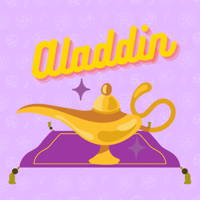
Explore this Show
Overview
Synopsis
Disney's Aladdin brings the famous animated film to life, on stage. In Agrabah, City of Enchantment, every beggar has a story and every camel has a tail! Aladdin, a kind but wily street urchin, falls in love with the beautiful Princess Jasmine, whom he knows is waaaaay out of his league. It just so happens, however, that the Sultan has declared Princess Jasmine must choose a husband. After she turns down the offers from various wealthy suitors, Aladdin -- with the help of a fast-talking, magical Genie -- introduces himself as wealthy suitor Prince Ali Ababwa. Meanwhile, evil royal advisor Jafar also has his sights set on the kingdom, and tries to convince the Sultan to force Jasmine to wed him. Will love conquer all? Perhaps - if love has a little help from a Genie.
Show Information
Context
Based on the original 1992 animated film of the same name, Aladdin opened on Broadway in 2014 and has since become the 7th highest-grossing Broadway production of all time. It has thus far been viewed by more than 15 million people in New York and been produced all over the world in the United States, Canada, the United Kingdom, Japan, Germany, Spain, and Australia to name a few.
The lyrics to the original film's songs were written by the late Howard Ashman and Tim Rice, with composer Alan
to read the context for Aladdin and to unlock other amazing theatre resources!Plot
Act One
The show opens with a narrator welcoming everyone to Agrabah: a city full of life, magic, and glamor. The narrator explains that Agrabah is most famous for its magic lamp and its diverse set of characters; villains, princesses, and street rats alike (“Arabian Nights”).
Soon after, we meet Aladdin, a young misfit who steals food from the marketplace to survive with his friends Kassim, Omar, and Babkak (“One Jump Ahead”). They are quick witted and clever, easily evading the guards.
to read the plot for Aladdin and to unlock other amazing theatre resources!Characters
| Name | Part Size | Gender | Vocal Part |
|---|---|---|---|
|
Lead |
Male |
Baritone |
|
|
Lead |
Male |
Tenor, Baritone |
|
|
Lead |
Male |
Baritone |
|
|
Lead |
Female |
Mezzo-Soprano |
|
|
Supporting |
Male |
Baritone |
|
|
Supporting |
Male |
Tenor, Baritone |
|
|
Supporting |
Male |
Tenor |
|
|
Supporting |
Male |
Tenor, Baritone |
|
|
Supporting |
Male |
Baritone |
|
|
Ensemble |
Either Gender |
Soprano, Mezzo-Soprano, Alto, Tenor, Baritone, Bass |
Songs
Act One
Act Two
A song with an asterisk (*) before the title indicates a dance number.
Monologues
Scenes
Key Terms
An adaptation is a reworking of a story from one medium or cultural context into another, such as turning a novel into a play or updating a classic play’s setting. Adaptations often reinterpret themes, characters, and style for new audiences. They can range from faithful recreations to bold reimaginings.
A ballad is a song style that tells a story through simple, lyrical verses and a steady rhythm. In theatre, ballads are often slow and emotional, allowing characters to reveal deep feelings or reflect on personal journeys. They can be used to highlight romance, longing, or moments of dramatic intensity.
The art of designing and arranging movement sequences for theatrical dance and physical storytelling.
A group of performers who comment on the action, originating in Ancient Greek theatre.
A group of performers who function as a unit in a production rather than as individuals with leading roles.
A genre of story involving magical and fantastical elements, sometimes adapted for theatrical performance.
An “I Want Song” is a number, usually placed early in a musical, where a main character expresses their deepest desire or ambition. This song sets the character’s journey in motion and gives the audience a clear emotional stake in the story. It has become one of the most recognizable and enduring conventions of musical theatre structure.
A form of government often portrayed in historical plays to explore lineage, power, betrayal, and class structures.
A running gag is a comedic device where a particular joke, situation, or character trait is repeated several times throughout a performance. Each recurrence builds familiarity, so the humor often increases as the audience begins to anticipate the repetition. For example, a character might always trip when entering a room or constantly forget names, creating laughter through expectation and variation.
Spectacle refers to the visual elements of a production that create wonder and excitement through design, movement, or scale. This might include elaborate costumes, dazzling choreography, special effects, or impressive sets. Spectacle often heightens the theatrical experience by leaving audiences with vivid visual impressions alongside the story and music.
A production created to showcase the talents of a specific star performer, often tailored to their strengths.
A sentimental ballad about unrequited love, often featured in musicals or cabaret performances.
Videos
Quizzes
Themes, Symbols & Motifs
Themes
Identity & Self-Discovery: Aladdin’s
to read about the themes, symbols and motifs from Aladdin and to unlock other amazing theatre resources!Quote Analysis
Sorry! We do not currently have learning modules for this guide.

